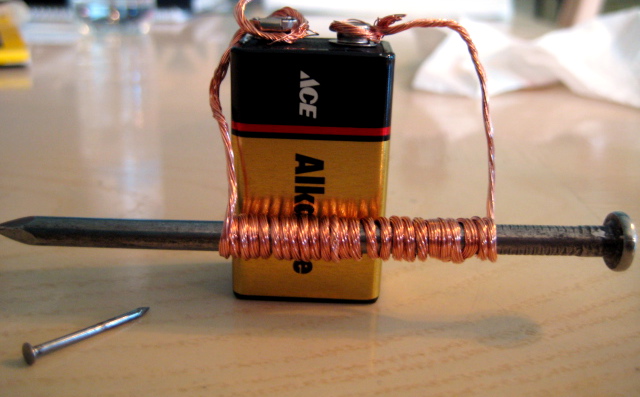Wikijunior:Big Book of Fun Science Experiments/How to Make an Electromagnet
If you get some copper wire and coil it up, and connect its ends to a small battery, you can make a weak electromagnet! To make an even stronger electromagnet, coil your copper wire around a large iron nail. The nail is induced to become a magnet (magnetic induction), and makes the whole thing stronger.
Materials
[edit | edit source]- long nail (or screwdriver, that is mostly a nail with a specific tip and a handle). Iron works best, but steel will work also.
- Roughly 1 meter (about 3 feet) of thin copper wire.
- A 6-volt or 9-volt battery.
- Any kind of steel material except galvanized.
Steps
[edit | edit source]- Wrap the wire around the screwdriver leaving a length on each end for connecting to the battery.
- Hook the wire to the battery by looping the ends of the length to each battery post.
- Tip: use a cloth to hold the battery as it will get hot after a few minutes.
- Holding the battery, bring the copper coiled nail close to the metal and observe how the screwdriver now acts as a magnet to attract the paper clip.
- To be safe and to save your battery, promptly disconnect the wire from the battery when you've finished the demonstration.
Physics
[edit | edit source]The atoms inside of magnets all line up the same way. In things that are not magnets, the atoms don’t line up. When the copper wire is coiled around an iron nail and attached to a battery, the atoms in the nail start to line up, too. Now the nail is also a magnet! As soon as you disconnect the battery, the nail and wire stop being a magnet. The electricity from the battery creates a magnetic field around the coiled wire and nail that acts just like a bar magnet.
